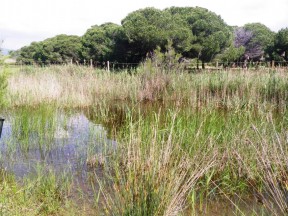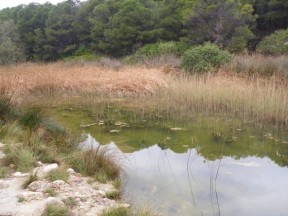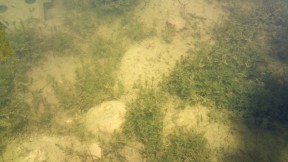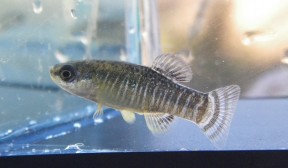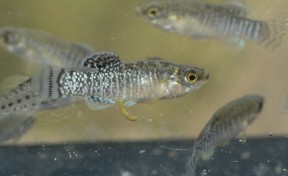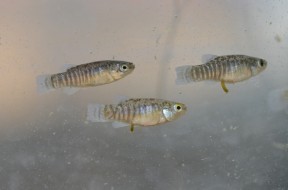Apricaphanius iberus
Spanish Toothcarp, Fartet (ES)
SynonymsTop ↑
Cyprinodon iberus Valenciennes, 1846
Etymology
Apricaphanius: from the Latin adjective apricus, meaning ‘sunny’ (given as “shining” by the authors), in reference to the many small white spots on the flanks of male individuals, in combination with the generic name Aphanius, within which genus members were formerly placed.
iberus: named for the Iberian Peninsula.
Classification
Order: Cyprinodontiformes Family: Aphaniidae
Distribution
Now restricted to a few small areas of the Spanish Mediterranean coastline in the autonomous communities of Catalonia, Valencia and Murcia. It used have a more-or-less continuous distribution from the north to the south of the country but there remain only 20 or so populations which are geographically isolated from one another.
The reasons for its decline are manifold but can all be attributed to the actions of man and include the introduction of non-native, highly-competitive species such as Gambusia holbrooki or Fundulus heteroclitus, degradation of habitats for tourism or agriculture and water pollution.
Most of the remaining populations are under threat and the species has already disappeared from southern France (although occurences there may represent misidentifications of A. fasciatus). It has been considered endangered by the IUCN since 1994 and captive breeding projects are underway but protection of its habitats remains woefully inadequate and a 2006 report concluded that its numbers may have declined by as much as 50% in the previous decade.
As a result of the lack of natural flow between populations the fish exhibit notable differences in genetic structure and in some cases patterning. It is therefore important that the different forms be labelled with the collection details by hobbyists and scientists alike in order to preserve bloodlines and maintain accuracy e.g. “Delta del Llobregat”, “Frá Ramón”, “Mar Menor”, etc.
Habitat
Found in various habitat types although it mostly inhabits shallow coastal waters such as lagoons, salt marshes and first order streams in areas where submerged vegetation and/or filamentous algae grow thickly during warmer months. It is highly adaptable and tolerant of a wide range of salinities from pure freshwater to hypersaline conditions and also occurs at some salt exploitation sites.
In the latter environments it is usually the only fish species present and abundant but when it occurs alongside Gambusia, Fundulus or predatory species such as Lepomis gibbosus or Micropterus salmoides (both also introduced) it can only be found in small numbers or has been displaced to more saline environments closer to the sea.
Maximum Standard Length
40 – 50 mm.
Aquarium SizeTop ↑
A pair or trio can be kept in a container with base dimensions of 60 cm x 30 cm or so but as a general rule members of this genus do better when maintained as a larger group in a space measuring upwards of 120 ∗ 30 cm.
Maintenance
Even for long-term maintenance a simple set-up will suffice. The most important factors are the provision of many broken lines of sight and a suitable medium in which the fish can deposit eggs. Female and subdominant male individuals must be offered the opportunity of respite from the aggressive alpha males during the spawning season so much of the available space can be filled with acrylic wool mops (use a fine grade if available), clumps of java moss or Ceratophyllum and ideally filamentous algae. There is no need to add a substrate although inert sand or gravel can be added if you prefer and filtration need not be too strong either.
It is possible, and preferable, to maintain it outdoors all year round in many countries and it will show better colours and overall condition if exposed to at least a few hours of natural sunlight each day. Try to find out the origin of your fish as some populations will do best in freshwater but if in doubt we recommend the addition of marine salt in the ratio of 1-3 g/L as most will need it.
Water Conditions
Temperature: Active over a wide temperature range of 2 – 30 °C. Artificial heating is not required in all but the coldest climates and it should be provided with a ‘winter’ period of several months during which it is maintained at low temperatures or it is likely to suffer both reduced fecundity and a shortened lifespan.
pH: 7.0 – 9.0. It will probably not survive under acidic conditions.
Hardness: 179 – 536 ppm
Diet
Apricaphanius species are basically micropredators feeding on small aquatic crustaceans, worms, insect larvae and other zooplankton although algae and other plant material is also taken at times. In the aquarium they will learn to accept dried foods in most cases but should also be offered regular meals of small live or frozen fare such as Artemia, Daphnia or bloodworm. This is particularly important during the months of spring and summer due to their high reproductive effort throughout this period. If the aquarium or container does not contain filamentous algae try to introduce a good quality dried product with added Spirulina content to the diet.
Behaviour and CompatibilityTop ↑
Its particular water requirements and aggressive spawning behaviour make A. iberus a poor choice for the community aquarium. Given its precarious conservation status the emphasis should also be on captive reproduction and we strongly recommend maintaining it alone. It should be kept in a group with a ratio of two or three females to each male being the ideal.
Sexual Dimorphism
As with all members of the genus sexual dimorphism is pronounced. Males exhibit a series of silvery vertical bars in the rear portion of the body with usually 3-4 darker bars in the caudal fin. The dorsal, ventral, anal and caudal fins are suffused with a light blue colouration with a dark base and distal band in the dorsal and anal. Females are larger and much plainer possessing only a series of variable small spots on the flanks and completely hyaline finnage.
Reproduction
A. iberus shows reproductive adaptations to unstable environments and fluctuating population sizes with a relatively short lifespan (<2 years in most cases), early sexual maturity (often within three months of age) and a high reproductive effort. Two generations are usually produced within a spawning season and a single female is capable of releasing up to 1000 eggs per year.
Captive reproduction is not difficult if the tank or container is properly arranged and maintained (see ‘tank set-up’). It is a fractional spawner with females depositing eggs on a more-or-less continuous basis between the months of April and September. Males form temporary territories which they defend against rivals while attempting to entice females to spawn. Dominant individuals will show more intense colouration. Eggs are released singly or in small batches and are attached to algae or other surfaces by means of small filaments. Aphanius typically eat their eggs/fry and the medium should therefore be checked on a daily basis during the spawning period.
The eggs must be treated carefully but can be handled if necessary. Alternatively the entire medium can be removed and replaced every couple of days. The medium/eggs should be transferred to a container with water of the same chemistry and temperature as that of the adults. The incubation period can vary a little with the temperature but is usually between 7 -14 days with the fry being large enough to accept Artemia nauplii, microworm etc. immediately after they become free-swimming.
NotesTop ↑
Populations of Apricaphanius from Spain’s southern, Atlantic coastline and Algeria previously considered representative of A. iberus have now been elevated to full species status with the names A. baeticus (Doadrio, Carmona & Fernández-Delgado, 2002) and A. saourensis (Blanco, Hrbek & Doadrio, 2006), respectively. All three species look broadly similar although A. saourensis can be easily identified as the patterning in males is mottled and does not form vertical bars, while females are totally plain except for a spot at the caudal peduncle.
A. baeticus is more similar but can be distinguished from A. iberus by possessing 8-9 (usually 8) branched dorsal fin rays (vs. 8-9, sometimes 10), 9-11 branched anal fin rays (vs. 8-9), a deeper, more elongate body shape, noticeably shorter snout, relatively thick (vs. thin) vertical bars in males and a flank patterning consisting of a few large (vs. numerous, small) dark markings in females. The three species are thought to have diverged from one another around 5 million years ago, around the time of the opening of the Straits of Gibraltar.
You’re unlikely to find it on sale in aquatic stores as its collection and trade are currently prohibited although it may be available via specialist breeders or associations from time-to-time. While Aphanius are certainly not as colourful as some of their relatives their interesting behaviour and continuous activity make them fascinating aquarium subjects and well worth a try if you possess the dedication to take on a long-term maintenance project since conservation is key with all members of the genus.
It currently contains 22 species and subspecies which are thought to have derived from a common ancestor originally distributed around the periphery of the former Tethys Sea. None are particularly well-documented in aquarium literature although some are very beautiful and the majority are not too difficult to maintain and breed. Sadly most are on the verge of extinction for one reason or another with several existing only in remnant, highly-localised populations.
In practically all cases the root cause for this decline is the activity of humans and although some species are now protected by conservation law the mismanagement and degradation of their habitats continues at an alarming rate. A few species are still, inexplicably, listed as a species of Lebias by some sources although that name has long been considered a synonym of Cyprinodon by most authorities and an ICZN committee voted to suppress the name in favour of Aphanius as recently as 2003.
References
- Doadrio, I., J. A. Carmona and C. Fernández-Delgado, 2002 - Folia Zoologica 51(1): 67-79
Morphometric study of the Iberian Aphanius (Actinopterygii, Cyprinodontiformes), with description of a new species. - Hrbek, T. and A. Meyer, 2003 - Journal of Evolutionary Biology 16(1): 17-36
Closing of the Tethys Sea and the phylogeny of Eurasian killifishes (Cyprinodontiformes: Cyprinodontidae). - Oliva-Paterna F.J., M. Torralva M and C. Fernández-Delgado, 2006 - Environmental Biology of Fishes 75: 307-309
Threatened fishes of the world: Aphanius iberus (Cuvier & Valenciennes, 1846) (Cyprinodontidae).


